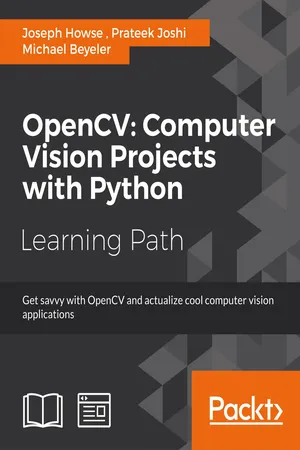
- 558 pages
- English
- ePUB (mobile friendly)
- Available on iOS & Android
OpenCV: Computer Vision Projects with Python
About this book
Get savvy with OpenCV and actualize cool computer vision applications
About This Book
- Use OpenCV's Python bindings to capture video, manipulate images, and track objects
- Learn about the different functions of OpenCV and their actual implementations.
- Develop a series of intermediate to advanced projects using OpenCV and Python
Who This Book Is For
This learning path is for someone who has a working knowledge of Python and wants to try out OpenCV. This Learning Path will take you from a beginner to an expert in computer vision applications using OpenCV. OpenCV's application are humongous and this Learning Path is the best resource to get yourself acquainted thoroughly with OpenCV.
What You Will Learn
- Install OpenCV and related software such as Python, NumPy, SciPy, OpenNI, and SensorKinect - all on Windows, Mac or Ubuntu
- Apply "curves" and other color transformations to simulate the look of old photos, movies, or video games
- Apply geometric transformations to images, perform image filtering, and convert an image into a cartoon-like image
- Recognize hand gestures in real time and perform hand-shape analysis based on the output of a Microsoft Kinect sensor
- Reconstruct a 3D real-world scene from 2D camera motion and common camera reprojection techniques
- Detect and recognize street signs using a cascade classifier and support vector machines (SVMs)
- Identify emotional expressions in human faces using convolutional neural networks (CNNs) and SVMs
- Strengthen your OpenCV2 skills and learn how to use new OpenCV3 features
In Detail
OpenCV is a state-of-art computer vision library that allows a great variety of image and video processing operations. OpenCV for Python enables us to run computer vision algorithms in real time. This learning path proposes to teach the following topics. First, we will learn how to get started with OpenCV and OpenCV3's Python API, and develop a computer vision application that tracks body parts. Then, we will build amazing intermediate-level computer vision applications such as making an object disappear from an image, identifying different shapes, reconstructing a 3D map from images, and building an augmented reality application, Finally, we'll move to more advanced projects such as hand gesture recognition, tracking visually salient objects, as well as recognizing traffic signs and emotions on faces using support vector machines and multi-layer perceptrons respectively.
This Learning Path combines some of the best that Packt has to offer in one complete, curated package. It includes content from the following Packt products:
- OpenCV Computer Vision with Python by Joseph Howse
- OpenCV with Python By Example by Prateek Joshi
- OpenCV with Python Blueprints by Michael Beyeler
Style and approach
This course aims to create a smooth learning path that will teach you how to get started with will learn how to get started with OpenCV and OpenCV 3's Python API, and develop superb computer vision applications. Through this comprehensive course, you'll learn to create computer vision applications from scratch to finish and more!.
Frequently asked questions
- Essential is ideal for learners and professionals who enjoy exploring a wide range of subjects. Access the Essential Library with 800,000+ trusted titles and best-sellers across business, personal growth, and the humanities. Includes unlimited reading time and Standard Read Aloud voice.
- Complete: Perfect for advanced learners and researchers needing full, unrestricted access. Unlock 1.4M+ books across hundreds of subjects, including academic and specialized titles. The Complete Plan also includes advanced features like Premium Read Aloud and Research Assistant.
Please note we cannot support devices running on iOS 13 and Android 7 or earlier. Learn more about using the app.
Information
OpenCV: Computer Vision Projects with Python
Table of Contents
Table of contents
- OpenCV: Computer Vision Projects with Python